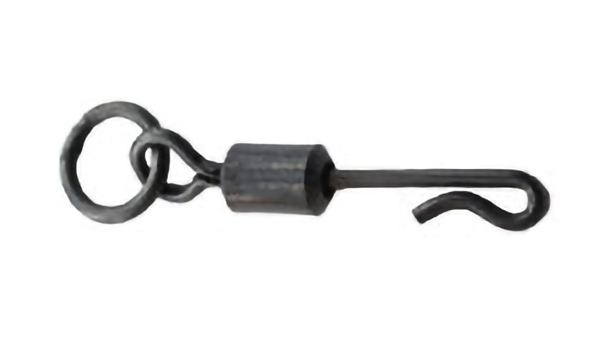

Fishing swivels might seem like a simple accessory, but […]
Fishing swivels might seem like a simple accessory, but they play a crucial role in the fishing process. Whether you’re a beginner or an experienced angler, it’s important to understand fishing swivels. Understanding their types and functions not only helps improve fishing efficiency but also protects your fishing gear and reduces unnecessary frustrations.
When fishing, especially with long lines or when large fish are struggling, line twisting and tangling is a common problem. The design of fishing swivels effectively solves this issue. They distribute the twisting force of the fishing line, preventing tangles or knots from forming in the line during the cast or retrieve.
Fishing swivels help reduce the rotational force exerted on the fishing line, which minimizes uneven stress and prevents knots from forming. This is especially important when using rotating lures or when fish are fighting on the line. Without a swivel, the fishing line can quickly become tangled, disrupting the fishing process.
Line twisting can cause anglers to frequently untangle knots, wasting time and potentially resulting in mistakes or lost fish. Over time, the twisting problem worsens, negatively affecting the fishing experience and efficiency.

Fishing swivels not only prevent tangling but also improve overall efficiency during fishing. Whether you are doing saltwater fishing, freshwater fishing, or using various baits, selecting the right swivel can be advantageous in different fishing environments.
In different fishing environments, the purpose of fishing swivels varies. For example, in saltwater fishing, the swivels need to be highly resistant to corrosion, as saltwater accelerates metal corrosion. In freshwater fishing, swivels may need to be lighter and smoother to help the angler operate more easily.
By using the right fishing swivel, anglers can handle the fishing line more smoothly, improving the overall catch rate. For example, in saltwater fishing, the correct swivel can prevent the bait from spinning uncontrollably, helping it move naturally and attract more fish.
The quality and performance of a fishing swivel directly affect the lifespan and durability of fishing lines. Swivels reduce friction between the fishing line and other tackle components, which slows down wear and tear. Regular inspection and replacement of swivels are crucial to maintaining the condition of fishing gear.
When the fishing line moves smoothly through the swivel, the friction between the line and other metal components is minimized, which helps protect the line from damage, aging, or breakage over time.
If fishing swivels are not chosen correctly or replaced when needed, it may lead to frequent line breakages or tackle damage, resulting in higher costs for gear replacements. Understanding the service life of swivels and proper maintenance techniques can help anglers extend the life of their gear and save on unnecessary expenses.
Fishing swivels make the fishing line move more smoothly through the water, reducing knots and tangles, which improves the overall comfort of fishing. Whether you’re a beginner or an experienced angler, using the right swivel can make the fishing process smoother, with fewer complications.
Tangles or knots can disrupt the flow of fishing and cause unnecessary delays. Using the right fishing swivel minimizes these interruptions, allowing anglers to stay focused on the core activity—waiting for and catching fish.
When the fishing line remains untangled and moves without resistance, anglers do not need to repeatedly untangle knots or adjust the line, saving time and increasing the overall comfort of the fishing experience. A smoother process makes fishing more enjoyable.
Fishing swivels come in various sizes and designs, suited for different fishing environments and conditions. Whether it’s saltwater fishing, lake fishing, or stream fishing, each environment has specific needs for the swivel. Understanding the types and functions of swivels allows anglers to choose the most suitable ones based on the conditions.
In saltwater environments, fishing swivels need to have excellent corrosion resistance and durability, whereas in freshwater, they tend to focus more on lightweight and smoothness. Different swivels are designed to perform best under various conditions, ensuring better fishing results.
Fishing swivels help anglers maintain better control over the fishing line, preventing issues like line tangles or breakages that could lead to safety risks. For example, a swivel can help avoid line breakage caused by twisting under heavy strain from a fighting fish, offering additional safety.
Proper use of a fishing swivel ensures the fishing line doesn’t easily break, especially when fighting large fish. If a line breaks due to a knot or twist, the angler loses the fish and may even risk injury. Using a high-quality swivel can significantly reduce these incidents, enhancing safety.
Fishing swivels come in many types, including closed-ring swivels, open-ring swivels, and quick-rotate swivels, each with its specific use case. Knowing the features of each type of swivel allows anglers to choose the right one based on their specific needs.
| Type of Swivel | Description | Best Use Case |
|---|---|---|
| Closed-Ring Swivel | Features a fixed closed ring for secure connections | Ideal for attaching hooks and lures |
| Open-Ring Swivel | Features an open ring for quick attachment and changes | Perfect for switching out hooks quickly |
| Quick-Rotate Swivel | Allows rapid rotation to reduce line twisting | Best for heavy-duty fishing scenarios |
Each type of swivel serves a unique purpose, and understanding these types ensures you choose the most effective one for your fishing style and environment.
Using the wrong swivel for your fishing needs can lead to various issues, including line breakage, loss of fish, or tackle damage. Understanding the types and functions of fishing swivels helps anglers avoid these common problems.
Using an inappropriate swivel might lead to frequent tangles or broken lines. By selecting a swivel that matches your fishing environment and requirements, you can significantly reduce these problems and enjoy a smoother, more successful fishing experience.